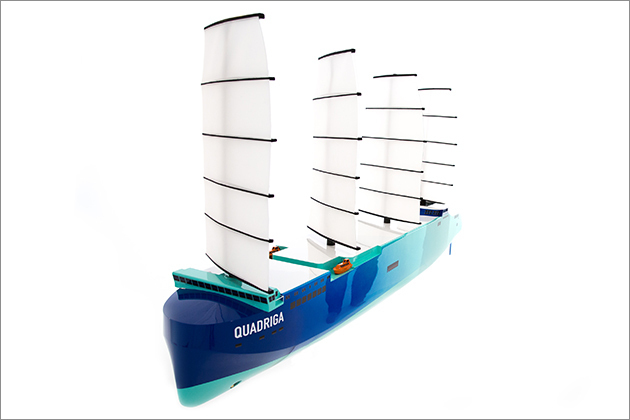Lloyd’s Register (LR) has joined the Quadriga sustainable shipping project – an initiative from Hamburg-based Sailing Cargo, which aims to build the world’s biggest sailing cargo ship.
The project outlines a plan to build a 170-meter car carrier, capable of carrying between 1,700 and 2,000 cars, which will be equipped with four DynaRig masts and will operate on hybrid propulsion with sails and diesel-electric engines, and an optional battery system for peak loads, according to LR. The vessel will be capable of sailing at 10 to 12 knots with the aim of reaching 14 to 16 knots in the next few years through combined expertise.
Wind-assisted propulsion offers one of the few realistic options for introducing renewable power into shipping, LR stated. The IMO target for CO2 emissions requires a 50 percent reduction in global ship-sourced CO2 emissions by 2020, this means significant changes in the industry are required. LR said its Low Carbon Pathways 2050 study found that low carbon ships will need to enter the fleet by 2030 to help achieve this goal.
The big question, LR said, is whether the technology will be available on the scale needed to achieve the level of reduction required. The consensus is that engineering advances alone and the associated efficiency gains will simply not be enough to meet the IMO target. Fuels will have to change and the Quadriga project provides one of the potential viable alternative solutions.
Other Solutions
In New York, the 600-passenger Hornblower Hybrid ferry cuts fuel use and lower emissions by combining clean power from several sources, according to a company statement.
The Hornblower Hybrid is said to run on renewable power generated by hydrogen fuel cells, solar panels and wind turbines with an energy storage system of 192 batteries. “Efficient diesel engines” kick in to cover additional needs, the company said. But despite several inquiries, Hornblower would not reveal how much power it actually gets from the different power sources.
Sailing in the Baltic, Viking Line plans to install a rotor sail on the dual-fuelled Viking Grace. The manufacturer of the sail claims it will reduce the cruise ferry’s LNG consumption by 300 tons a year. Viking Line cited studies that indicated up to 20 percent fuel savings per year.
The next Viking vessel, to be built in China, will have two sail towers.
The rotor sails are 24 meters tall and 4 meters in diameter. The manufacturer did not respond to inquiries for more detailed information.
Other companies are exploring more ideas, including airborne wind energy from drones generating electricity from wind at altitudes of 500 to 1,500 meters above the ship.




